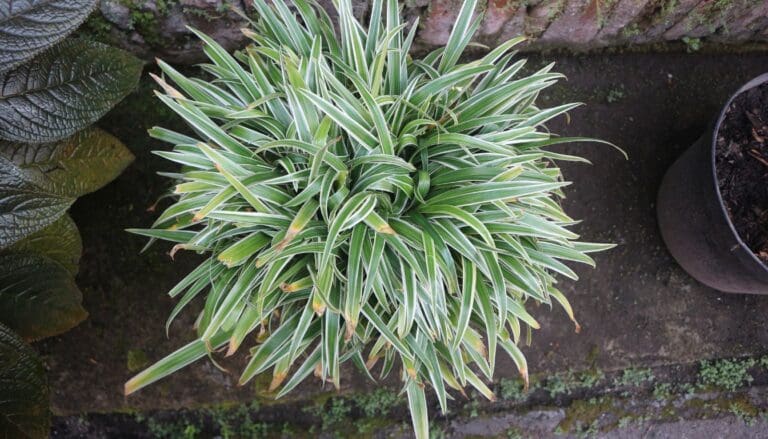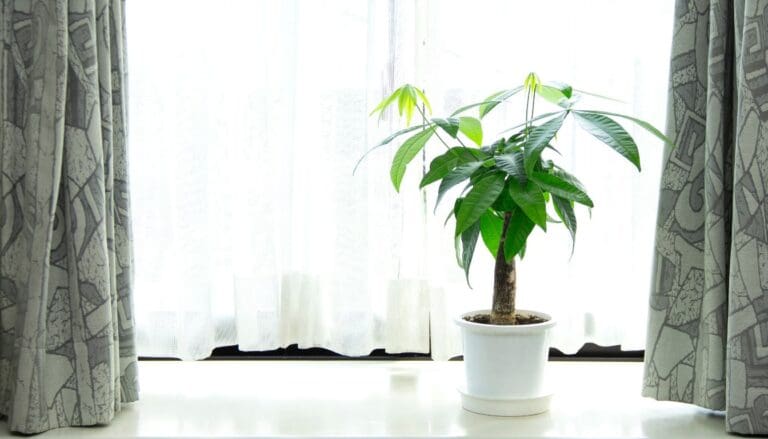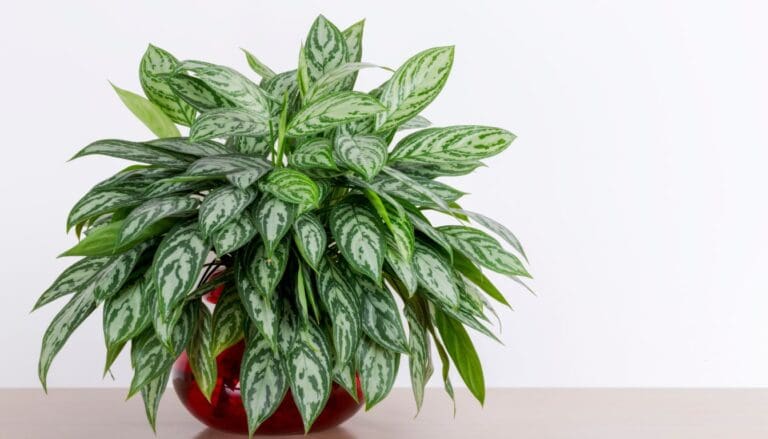11 Reasons Why Your Schefflera Plant Is Not Growing(+Tips To Boost Growth)
Schefflera are loved houseplants popularly known for their umbrella-shaped foliage. Schefflera are fast-growing plants, but it is very disheartening to see them not grow even after getting proper attention.
If your Schefflera is not growing during winter, it’s natural as the plant remains dormant. But other than that, improper watering, incorrect lighting, insufficient nutrition, and pests can affect the plant’s growth. Identify the exact cause and fix it to see your Schefflera grow again.
Keep reading this article to learn about the causes behind no growth in the Schefflera plant and how to encourage proper growth.
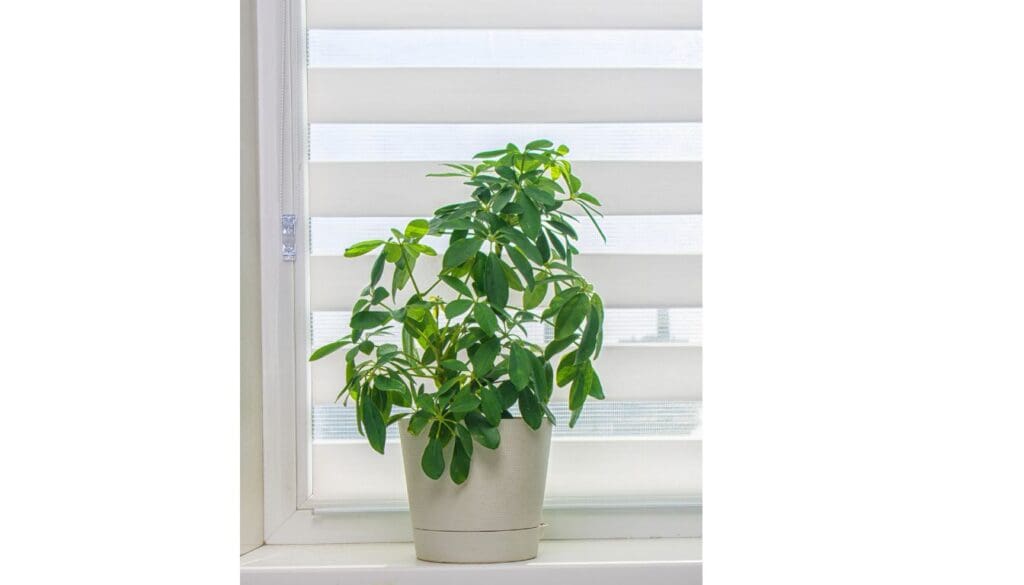
Please note: Simplify Plants is reader-supported. Some links in the post are affiliate links and I get a commission from purchases made through links in the post.
How fast does Schefflera grow?
Schefflera plants are considered fast growers only if they get the proper growing conditions.
This plant can grow at least 3 feet per year when planted outdoors and 1-2 feet per year when planted indoors.
Schefflera usually grow approximately 8 feet tall and take 2-3 years to completely mature.
The growth rate of a Schefflera plant depends on the light, humidity, water, and temperature it gets.
Schefflera grows best during its growing season, i.e., summer and spring season but doesn’t show any growth during the winter months.
If you notice that your plant is growing slower than the actual speed, something is inaccurate.
Why is my Schefflera not growing?
You may think you are providing proper care to your umbrella plant, but there is still something wrong due to which your plant is showing no growth.
The plant can stop growing without receiving the appropriate care.
But don’t worry about it and try to find the exact reasons to fix the problem fast.
Now let’s discuss all the factors one by one which is responsible for poor growth in the Schefflera plant.
Improper lighting

As Scheffleras are tropical plants, they need bright indirect sunlight to thrive.
The growth can stop completely if the plant receives low light for a prolonged period.
Due to low light, the plant fails to perform photosynthesis which leads to no growth.
Schefflera can also become prone to various pests and fungal diseases due to low light directly affecting the plant’s growth.
Leggy growth, faded foliage, weak stems, and small leaves are the common signs of insufficient sunlight.
Similarly, exposing the Schefflera to direct light can also stop the growth.
Direct sunlight causes scorching of leaves and brown tips or edges on the leaves.
Because of excessive exposure, the plant loses moisture at a very faster rate, due to which it suffers from dehydration, and the plant becomes weak and stops growing.
Incorrect watering
You need to maintain a proper watering schedule for your Schefflera for healthy and proper growth.
Otherwise, you will have to face the consequences like no growth.
Incorrect watering can cause both underwatering and overwatering problems.
When your Schefflera experiences underwatering, it fails to get enough moisture and nutrients from the soil, causing dehydration to the plant.
Because of dehydration, the plant becomes weak, resulting in poor growth.
Crispy leaves, brown edges or tips, and falling leaves are the common signs of underwatering.
Whereas, when Schefflera experiences overwatering, the oxygen supply inside the soil reduces, due to which the roots suffocate and refuse to perform their basic function.
This causes weakness in the plant, and it stops growing.
Discolored, wilting, brown leaves and foul smell from the soil are the common signs of overwatering.
Inadequate fertilization

Fertilization is necessary for promoting the healthier and faster growth of a plant.
Soil doesn’t have all the nutrients your plant needs, so fertilizing is important for providing those nutrients.
The absence of necessary nutrients causes weakness in the plant, which refuses to grow.
On the other hand, over-fertilization can also stop the growth of your Schefflera plant.
Due to overfertilization, the soil’s acidity increases, burning the entire root system.
When the roots become unhealthy, the umbrella plant automatically stops growing.
Excessive fertilization can also accumulate too much salt on the soil surface, which absorbs all the moisture causing dehydration to the plant.
Because of this, you will see no growth in your Schefflera.
A salt build-up in the soil surface, yellow leaves, and loss of leaves are the common signs of overfertilization.
Low humidity
Schefflera, a tropical plant, thrives in high humid conditions between 60-75%.
When the humidity drops below 55%, then the plant can experience growth problems.
Because of low humidity levels, the leaves lose moisture rapidly as the transpiration rate increases.
This causes dehydration to your plant resulting in poor growth.
Scorch, crispy, shriveled, and brown leaves are the common signs of low humidity.
Temperature stress
The Umbrella plant thrives in warm temperatures ranging between 65-75°F.
If you fail to provide its temperature demand, the plant can suffer from growth problems.
Schefflera cannot tolerate low temperatures that fall below 45°F.
Exposing the plant to extremely low temperatures and sudden temperature fluctuations can be very stressful.
This affects the growth of Schefflera, and then it stops growing.
Droopy, faded leaves, and stunted growth is common symptoms of temperature stress.
Wrong soil mix
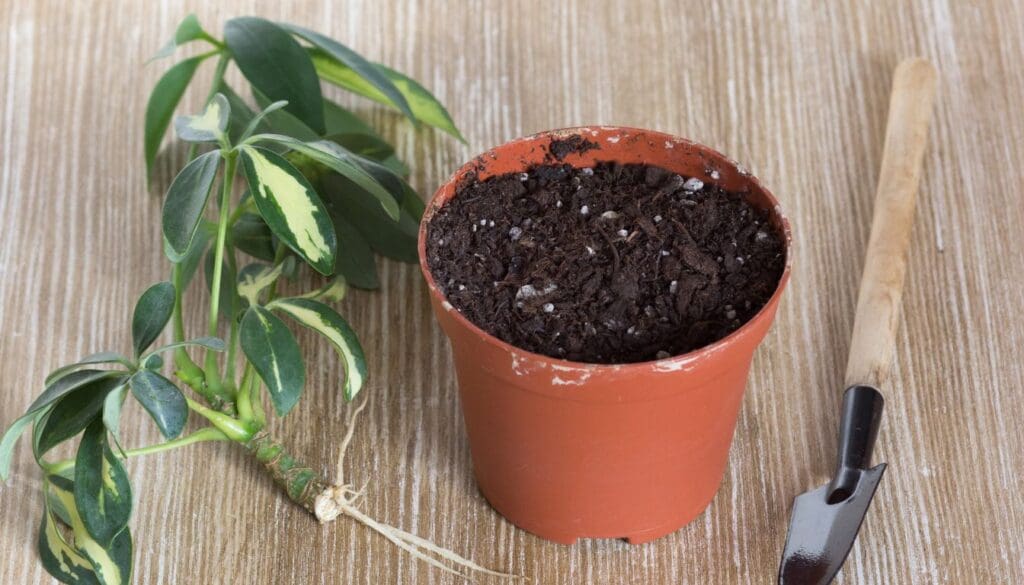
Schefflera prefers soil that has well drainage power and good moisture retention.
If the plant grows in the wrong soil mix, it can have stunted growth.
If the soil is too dense, it will absorb excess moisture that will cause overwatering issues frequently.
Because of this, the plant can suffer from root rot disease, and the growth can completely stop due to damaged roots.
If the soil is too loose, roots fail to absorb sufficient moisture and nutrients, which leads to underwatering issues, and the plant eventually stops growing.
Therefore, choosing the preferred soil mix for Schefflera is necessary if you don’t want your plant to suffer from growth issues.
Incorrect pot size
Incorrect pot size can be one of the reasons behind stunted growth in your Schefflera plant.
If the pot is too small for the plant, the roots will fail to grow in such limited space and can get root-bound.
But when the pot is too large, it will hold excess soil and water than required, which will cause overwatering issues too frequently.
Under this situation, it will not let your Schefflera grow efficiently.
Stress
If your Schefflera is facing any stress, it can stop its growth.
If you have recently re-potted your plant, it becomes difficult for the plant to adjust to the new environment.
That is why you can see your Schefflera has stopped growing for a while.
Other problems can cause sudden shock or stress to the plant. Such as:
- Sudden temperature fluctuations
- Changing location often
- Cold or hot drafts
- Air currents
Try to find out why your Schefflera is stressed and then fix it to keep the plant away from stress.
Pest infestation

Pests like scales, aphids, mealybugs, fungus gnats, broad mites, and spider mites can easily strike Schefflera if exposed to unfavorable conditions.
If Schefflera experiences overwatering, high humidity, and high-temperature problems, the pests can easily attack the plant.
The pests take out all the sap that is necessary for growth.
Because of an absence of nutrients, the plant becomes weak and spiritless and stops growing.
Pests are a serious issue; they can even kill your plant if it remains unnoticed.
Check the underside of the leaves, as most of the pest hides in those areas.
Lack of pruning
Pruning is necessary for encouraging the plant to grow healthier and bushier.
Not pruning on time can cause stunted growth in your Schefflera plant.
Lack of pruning doesn’t give proper space to the plant for new growths.
Any disease that already infects the leaves can also spread to other remaining parts.
This reduces growth and can cause extreme damage and weakness to the plant.
If you don’t want your Schefflera plant to stop growing completely, try to prune the extra damaged parts or leaves on time.
Dormancy period
Schefflera, grow best during the summer and spring as it is their growing period.
But when winter arrives, Schefflera plants automatically switch themselves into dormancy.
It happens because, during low temperatures, Scheffleras finds difficulty in surviving, so they mostly focus on saving their energy and taking rest rather than growing.
This is natural.
So, if you notice that your Schefflera has stopped growing during winter, you don’t have to worry about this.
The plant will eventually grow normally when the weather becomes quite warm.
How can I make my Schefflera grow?
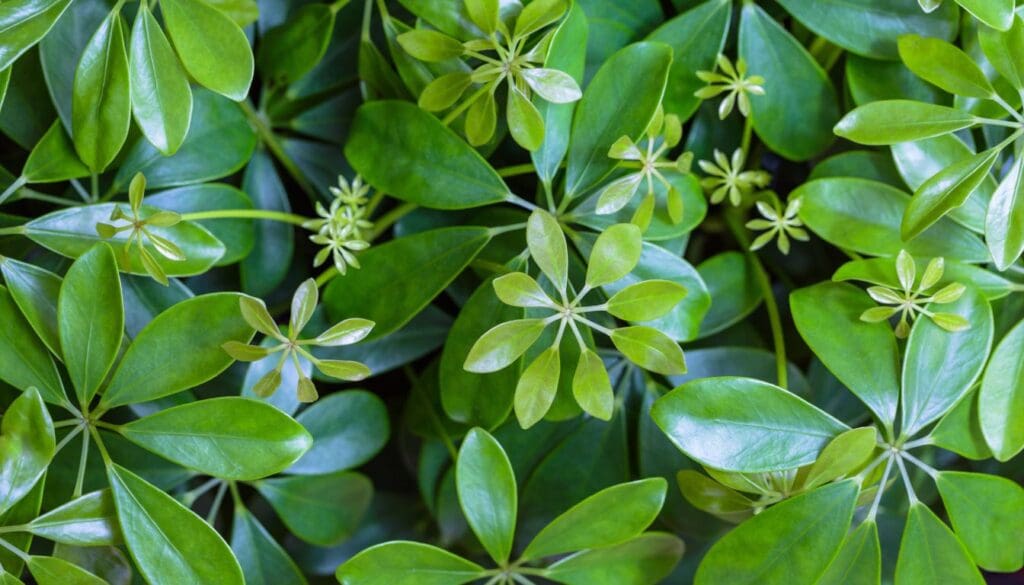
Schefflera is a low-maintenance plant, but that doesn’t mean you will neglect its basic needs.
Schefflera plants need proper growing conditions, the right care, and attention if you want them to grow efficiently.
Let us discuss all the ways that can encourage your Schefflera’s growth.
Give proper light
Schefflera plants need at least 4 hours of bright indirect light daily to thrive.
If the light is low, you can give some extra hours of sunlight if you want.
East and north-facing windows are considered the most preferred spot as the light is indirect in these areas.
Otherwise, if the light intensity is very low, you can keep the plant near a south or west-facing window but only after filtering the direct light by using sheer curtains.
Always keep the plant 5-10 feet away from the window according to the light intensity.
Otherwise, the plant can get stressed.
Rotate the Schefflera twice a week to provide equal light at every corner.
If natural light is not enough, you can also use artificial light as it works.
Maintain proper watering

Schefflera loves to grow in moist soil and needs watering every week during their growing season.
Before watering, always check the soil’s moisture level by inserting a finger into the soil or using a moisture meter.
Water only when the topsoil is 70% dry.
If it’s not, then wait for some time.
Always water thoroughly until the water drains out from the drainage holes.
If your umbrella plant experiences overwatering, stop watering until the soil becomes dry and place the plant in bright indirect sunlight.
If your Schefflera is still not recovering, then take out the plant from the pot and check whether it has root rot or not.
If yes, repot the plant into a new container with a new soil mix by eliminating infected roots.
Reduce the frequency of watering during the winter months as the plants stay in a dormant period.
Provide proper fertilizer
To encourage proper Schefflera growth, you need to fertilize the plant on time without delay.
The fertilizer should contain a proper balance of Nitrogen, Potassium, and Phosphorous.
Fertilize the Schefflera with well-balanced liquid fertilizer in the NPK ratio of 20-20-20.
Before fertilizing, dilute the liquid fertilizer with water to make it half-strength, and then use it.
If you have overfertilized your Schefflera plant, remove the top layer of the soil and add a new layer.
Then give a proper wash to the soil by watering thoroughly.
Continue this for some time until the excess fertilizer is completely washed out from the soil.
You can simply remove the entire soil and add a new mix by repotting it.
Don’t fertilize during the winter months because of dormancy.
Maintain appropriate temperature
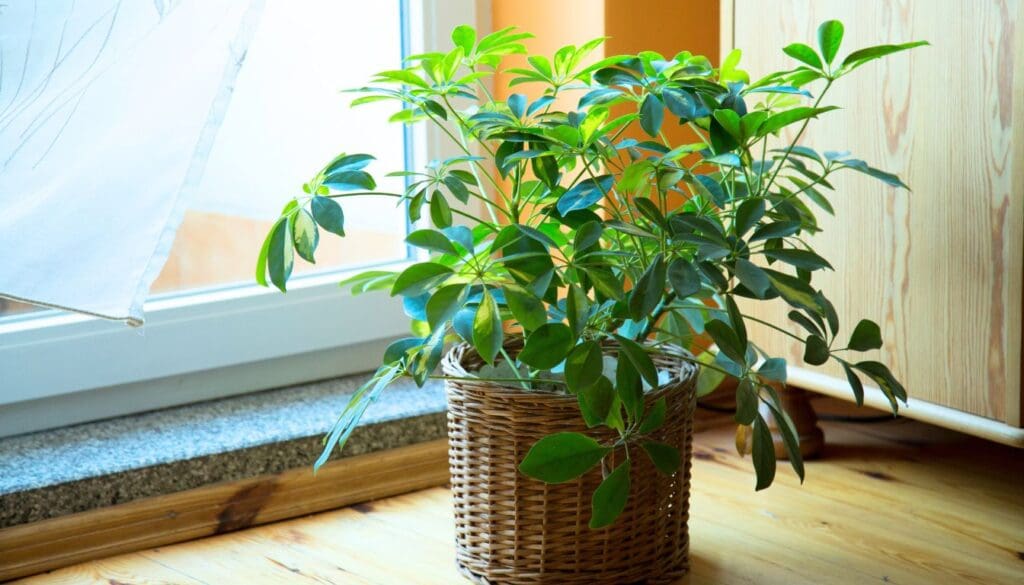
Schefflera thrives in warm temperatures ranging between 65-75°F.
Avoid keeping the plant near heating or cooling objects like heaters, vents, chimneys, Air conditioners, and near refrigerators.
Also, don’t keep the plant in those areas where the door or windows open and close quite often.
A sudden change in temperatures can create stress.
To check the temperature or humidity, you can use a hygrometer.
This will help you to find out whether the plant needs any change in temperatures or not.
You can adjust the temperature inside by using a thermostat device.
Also, during winter, try not to keep the plant near frosty windows and cold drafts.
Always protect the plant from such a climate.
Maintain humidity
It is quite difficult to maintain humidity inside the house, especially for plant-like Schefflera that need at least 60-75% humidity to thrive.
- Regular misting using a spray bottle can help increase humidity for a short duration.
- Grouping Schefflera with other houseplants is another method to raise humidity.
- You can also apply the pebble-tray method. Bring a tray, fill it with water and keep some pebbles. Then place Schefflera on top of the tray. Continuous evaporation will help to increase humidity in the plant.
- You can also use a humidifier to increase humidity. This is one of the best ways.
Choose the correct soil mix and pot size
To promote the healthy growth of Schefflera, use a potting mix that has good drainage, good moisture retention, and proper nutrients.
Prepare a soil mix that contains:
Make sure that potting mix is acidic with a pH level of 5.5 to 6.5.
The pot size for Schefflera should be 2 inches bigger than the plant’s size.
This will provide enough space for the roots to grow without getting root-bound.
You can use clay or a plastic pot to grow Schefflera and ensure it contains proper drainage holes.
Treatment of pests

If pests infect the plant, try to get rid of them as quickly as possible.
Let us discuss how you can remove pests from the plant.
- Give your Schefflera a good wash by using a strong spray of water. After that, keep the plant in a brighter location.
- If any pests are visible, handpick them by using gloves.
- For removing the remaining pests, dip cotton balls in rubbing alcohol solution and then wipe the infected area.
- You can also use insecticidal soap to get rid of the pests. Make sure you read the instructions before using them.
- Prune all the damaged and infected parts with sterilized sharp scissors.
- After the plant is recovered, spray horticulture oil or neem oil every month to keep it away from future pest infestations.
Prune timely
Pruning is important if you want your Schefflera to grow healthy.
Try to prune regularly without delaying it.
When you notice any extra, damaged, or infected leaves immediately cut them off.
Make sure you make a clean cut without causing stress to the plant.
Use sharp and sterilized scissors or pruners to make that clean cut.
Continue to prune timely to encourage healthy and fast growth of your plant.
Take good care during the winter
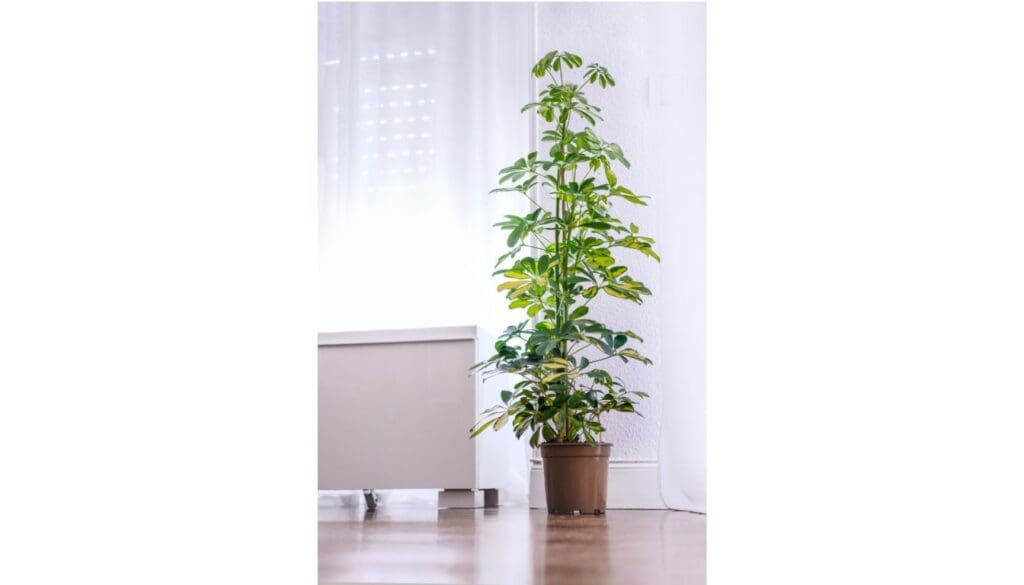
During winters, the requirements of the plant change.
Decrease watering during winter as the plant doesn’t consume much water during dormancy.
Always water after ensuring the topsoil is 75% dry as it can otherwise experience overwatering issues.
Avoid fertilizing during the winter season as the plant doesn’t need it.
You can keep the plant outside for some time when the light intensity is low.
This will provide some relief to the plant from the winter stress.
Don’t keep the plant near a window when the temperatures are extremely low.
This can create stress.
Final thoughts
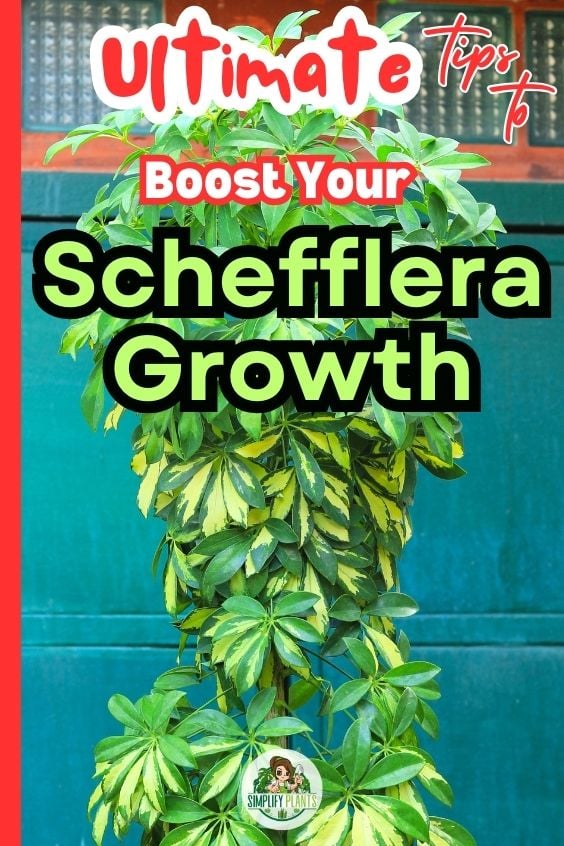
There can be many causes that can stop the growth of your Schefflera. But don’t be worried. Try to find out the problems and fix them.
To keep your Schefflera healthy, you must provide it with proper growing conditions. Ensure the plant gets proper water, light, soil, feeding, humidity, and temperatures.
Don’t worry if your Schefflera is not growing during the winter months, as it stays dormant. The plant will be normal again once the summer and spring season arrives.
Reference: Wikipedia, Sciencedirect, Britannica, American Society for Horticultural Science, Schefflera taxonomic history.
Recommended Garden Supplies
| Product Image | Our Recommended Gardening Supplies | Check Offers! |
|---|---|---|
Top Top
Top
Top
Top
Top
Top
Top
Top | rePotme Houseplant and Tropical Classic Potting Soil Mix | Check Offer On Amazon |
 Top
Top
Top
Top
Top
Top
Top
Top | Espoma Organic Indoor Plant Food | Check Offer On Amazon |
 Top
Top
Top
Top
Top
Top
Top
Top | GooingTop LED Grow Light 6000K Full Spectrum Clip Plant Growing Lamp | Check Offer On Amazon |
 Top
Top
Top
Top
Top
Top
Top
Top | Soil Moisture Meter | Check Offer On Amazon |
 Top
Top
Top
Top
Top
Top
Top
Top | Govee Hygrometer Thermometer, Bluetooth Enabled! | Check Offer On Amazon |
 Top
Top | LEVOIT Humidifiers for Large Room(Best For Plants) | Check Offer On Amazon |
 Top
Top
Top
Top
Top
Top
Top
Top | Upgraded DIY Automatic Drip Irrigation Kit, 15 Potted Houseplants Support | Check Offer On Amazon |
 Top
Top
Top
Top
Top
Top
Top
Top | Stainless Steel Heavy Duty Gardening Tool Set | Check Offer On Amazon |
 Top
Top
Top
Top
Top
Top
Top
Top | Bonide Insecticidal Soap | Check Offer On Amazon |
 Top
Top
Top
Top
Top
Top
Top
Top | Bonide 32 oz Spray Neem Oil for Organic Gardening | Check Offer On Amazon |
 Top
Top
Top
Top
Top
Top
Top
Top | Garden Safe Fungicide | Check Offer On Amazon |


